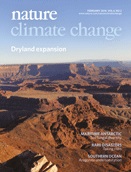본문
Role of Atlantic Ocean on Pacific changes
by Prof. Changhyun Yoo (cyoo@ewha.ac.kr)
Department of Atmospheric Science and Engineering

Earth’s energy is in balance when solar radiation reaching Earth is exactly compensated by outgoing longwave radiation to the space. With industrialization and escalated use of fossil fuels, greenhouse gas concentration in the atmosphere has been greatly increased. For example, when first measured in 1950s in Manua Loa, Hawaii, the carbon dioxide concentration marked approximately at 315 ppm. But now it has surpassed 400 ppm and keeps increasing with annual mean growth rate of 2-3 ppm per year (http://www.esrl.noaa.gov/gmd/ccgg/trends/). Enhanced greenhouse gas can greatly alter the global energy balance by trapping the heat escaping to the space. Such an anthropogenic boost in “greenhouse effect” is known to have contributed to “global warming”, i.e., an increase in the global mean surface temperature (GMST), arguably one of the most important climate variables for all living species on Earth.
It is therefore not surprising that great deal of attentions have been gathered when studies in climate science community have revealed a pause or “hiatus” in the recent GMST trend. Although a temporary staggering of GMST is not unprecedented in our empirical data, the timing of the recent hiatus is unforeseen to many of us because of the GMST trend having been very steady, positive at about 0.1 degree Celsius per decade until the sudden pause. In addition, no slow down has been observed in carbon dioxide concentration trend. As a result, this discovery has motivated many studies on the cause and projection of the global warming hiatus. At the same time, it has prompted the climate skeptics to raise their suspicion whether or not the current climate change is man made.
Since then, a series of papers have been published to understand the global warming hiatus. Although the underlying cause is not fully disclosed yet, we have gained some confidence to pinpoint what is the primary driver of the hiatus. For example, Kosaka and Xie (2013) concluded that the tropical eastern Pacific Ocean plays a key role regulating the GMST. This conclusion was made through the use of numerical simulations of a climate model with fully coupled atmosphere and ocean, except for the tropical eastern Pacific sea surface temperatures (SSTs) being cooled to historical values, which successfully reproduced the observed hiatus. Along this chain, subsequent studies, such as England et al. (2014), added a link that the eastern Pacific cooling was associated with acceleration in equatorial trade wind contributing to the SST anomalies through wind-evaporative-feedback process.
Now the question is on the cause of the trends in trade wind and eastern Pacific SSTs. While recent studies, e.g., McGregor et al. (2014), focus on the relationship between Atlantic warming and Pacific cooling through changes in Walker circulation, the study by Li et al. here shows that such an atmospheric bridge can be established from the Atlantic to the Indo-Western Pacific warm pool area as well on decadal time scales. This result suggests a much tighter link among all three tropical ocean basins than previously thought. Of course the result of Li et al. should be taken with cautions due to limitations of climate models. However, they present that the atmospheric bridge can be found from a series of hierarchy in complexity of models, which suggest robustness of the mechanism.
There are still remaining questions on the global warming hiatus, and the proposed mechanisms need to be re-assessed and confirmed in the community. For example, although many studies support a view that the global warming hiatus is naturally occurring via the above processes, as well as decadal variability of North Pacific Ocean, there are modeling evidences suggesting that anthropogenic aerosols may play an important role in triggering the global warming hiatus. That being said, the third super El Niño that we are experiencing now will leave an unmistakable mark on the GMST and will revive the global warming.
* Related article and site
Li, X., S.-P. Xie, S. T. Gille, and C. Yoo (2015), Atlantic-induced pan-tropical climate change over the past three decades, Nature Clim. Change, published online., doi: 10.1038/nclimate2840.
Kosaka, Y., and S.-P. Xie (2013), Recent global-warming hiatus tied to equatorial Pacific surface cooling, Nature, 501(7467), 403-407, doi: 10.1038/nature12534.
England, M. H., and Coauthors (2014), Recent intensification of wind-driven circulation in the Pacific and the ongoing warming hiatus, Nature Clim. Change, 4(3), 222-227, doi: 10.1038/nclimate2106.
McGregor, S., A. Timmermann, M. F. Stuecker, M. H. England, M. Merrifield, F.-F. Jin, and Y. Chikamoto (2014), Recent Walker circulation strengthening and Pacific cooling amplified by Atlantic warming, Nature Clim. Change, 4(10), 888-892, doi: 10.1038/nclimate2330.